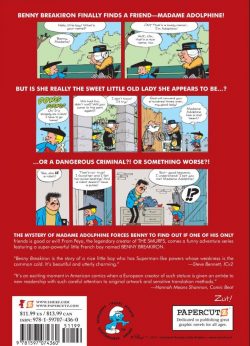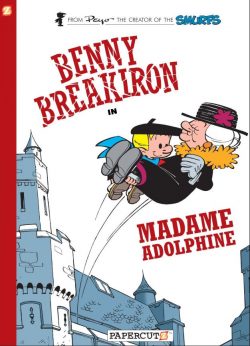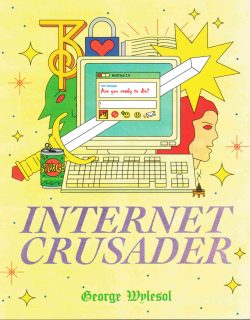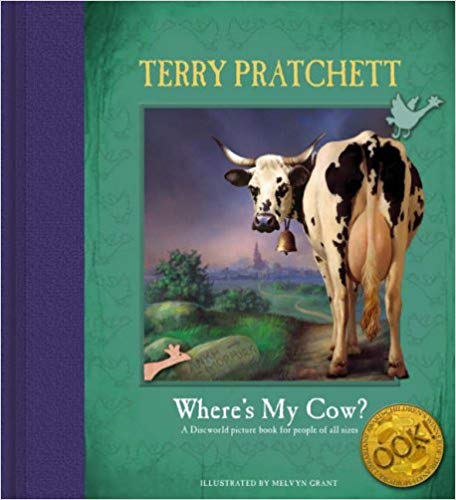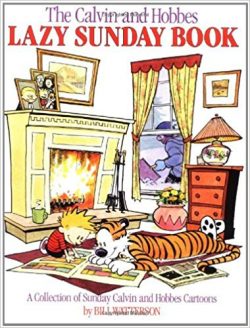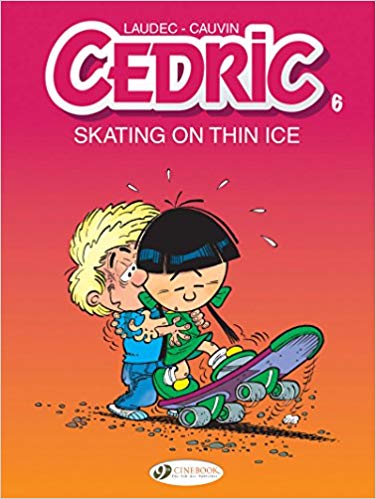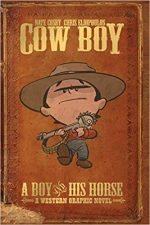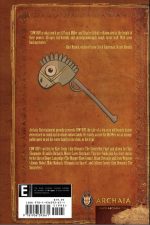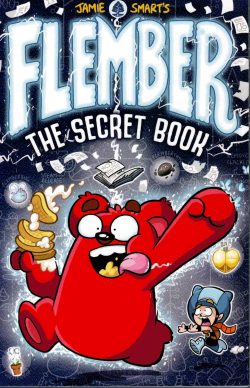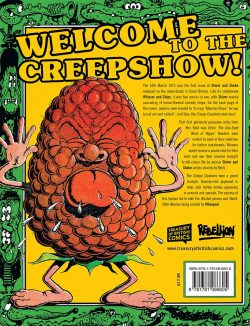
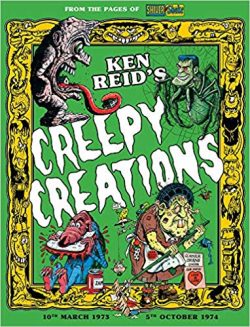
By Ken Reid, with Reg Parlett, Robert Nixon & various (Rebellion Studios)
ISBN: 978-1-78108-660-5 (HB)
Win’s Christmas Gift Recommendation: Hopelessly Hilarious Horrendousness… 10/10
If you know British Comics, you’ll know Ken Reid.
He was one of a select and singular pantheon of rebellious, youthful artistic prodigies who – largely unsung – went about transforming British Comics, entertaining millions and inspiring hundreds of those readers to become cartoonists too.
Reid was born in Manchester in 1919 and drew from the moment he could hold an implement. Aged nine, he was confined to bed for six months with a tubercular hip, and occupied himself by constantly scribbling and sketching. He left school before his fourteenth birthday and won a scholarship to Salford Art School, but never graduated.
He was, by all accounts, expelled for cutting classes and hanging about in cafes. Undaunted he set up as a commercial artist, but floundered until his dad began acting as his agent.
Ken’s big break was a blagger’s triumph. Accompanied by his unbelievably supportive and astute father, Ken talked his way into an interview with the Art Editor of the Manchester Evening News and came away with a commission for a strip for its new Children’s Section.
The Adventures of Fudge the Elf launched in 1938 and ran until 1963, with only a single, albeit lengthy, hiatus from 1941 to 1946 when Reid served in the armed forces.
From the late 1940s onwards, Reid dallied with comics periodicals: with work (Super Sam, Billy Boffin, Foxy) published in Comic Cuts and submissions to The Eagle, before a fortuitous family connection (The Dandy illustrator Bill Holroyd was Reid’s brother-in-law) brought DC Thomson managing editor R.D. Low to his door with a cast-iron offer of work.
On April 18th 1953 Roger the Dodger debuted in The Beano. Reid drew the feature until 1959 and created numerous others including the fabulously mordant doomed mariner Jonah, Ali Ha-Ha and the 40 Thieves, Grandpa and Jinx amongst many more.
In 1964, Reid and fellow under-appreciated superstar Leo Baxendale jumped ship to work for DCT’s arch rival Odhams Press. This gave Ken greater license to explore his ghoulish side: concentrating on comic horror yarns and grotesque situations in strips like Frankie Stein, and The Nervs in Wham! and Smash! as well as more visually wholesome but still strikingly surreal fare as Queen of the Seas and Dare-a-Day Davy.
In 1971 Reid devised Faceache – arguably his career masterpiece – for new title Jet. The hilariously horrific strip was popular enough to survive the comic’s demise – after a paltry 22 weeks – and was carried over in a merger with stalwart periodical Buster where it thrived until 1987. During that time, he continued innovating and creating through a horde of new strips such as Harry Hammertoe the Soccer Spook, Wanted Posters, Martha’s Monster Makeup, Tom’s Horror World and a dozen others. One of those – and the worthy subject of this splendid luxury hardback (and eBook) is Creepy Creations.
Part of Rebellion’s ever-expanding Treasury of British Comics collected here are all 79 full colour portraits from Shiver & Shake episodes (spanning March 10th 1973 to October 5th 1974), plus related works from contemporary Christmas annuals.
After the initial suggestion and 8 original designs by Reid, Creepy Creations featured carefully crafted comedic horrors and mirthful monsters inspired by submissions from readers, who got their names in print plus the-then princely sum of One Pound (£1!) sterling for their successful efforts.
The mechanics and details of the process are all covered in a wealth of preliminary articles that begin with ‘Creepy Creation Spotter’s Guide’ listing the geographical locations so crucial to the feature’s popularity and is backed up by a fond – if somewhat frightful – family reminiscence from Anthony J. Reid (Ken’s son) in ‘The Erupting Pressure Cooker of Preston Brook’.
The convoluted history of Ken’s feature (which came and went by way of 1960s cult icon Power Comics, Mad magazine, Topps Trading Cards and even stranger stops and was originally intended to save him having to draw the same old characters every day) is detailed in an engrossing historical overview by Irmantas Povilaika dubbed ‘Plus a “Funny Monsters†Competition with These Fantastic Prizes’ before the real wonderment ensues…
Astounding popular from beginning to end, Creepy Creations offered a ghastly, giggle-infused grotesque every week: a string of macabre graphic snapshots (some, apparently, too horrific to be published at the time!) beloved by kids who adore being grossed out.
Seen here are ratified Reid-beasts like ‘The One-Eyed Wonk of Wigan,’, ‘The Chip Chomping Tater Terror of Tring’ and the ‘The Boggle-Eyed Butty-Biter of Sandwich’, his stunning kid collaborations on arcane animals like ‘The Gruesome Ghoul from Goole’ or ‘Nelly, the Kneecap-Nipping Telly from Newcastle’, and due to the stark demands of weekly deadlines, there are even cartoon contributions from UK comics royalty Reg Parlett and Robert Nixon.
Supplementing and completing the eldritch, emetic experience are a selection of Creepy Creations Extras, comprising images and frontispieces from Christmas Annuals, the entire ‘Creepy Creations Calendar for 1975’, four pages of ‘Mini Monsters’, and the entire zany zodiac of ‘Your HORRORscope’…
Adding even more comedy gold, this tome also includes tantalising excepts from the Leo Baxendale Sweeny Toddler compilation and Reid’s magnificent World-Wide Wonders collection…
Ken Reid died in 1987 from the complications of a stroke he’d suffered on February 2nd at his drawing board, putting the finishing touches to a Faceache strip. On his passing, the strip was taken over by Frank Diarmid who drew until its cancelation in October 1988.
This astoundingly absorbing comedy classic is another perfect example of resolutely British humorous sensibilities – absurdist, anarchic and gleefully grotesque – and these cartoon capers are amongst the most memorable and re-readable exploits in all of British comics history: painfully funny, beautifully rendered and ridiculously unforgettable. This a treasure-trove of laughs to span generations which demands to be in every family bookcase.
© 1973, 1974, & 2018 Rebellion Publishing Ltd. All Rights Reserved.

